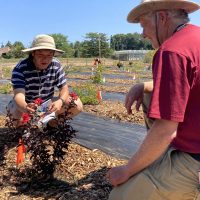The Weekly Dirt 9.22.21
9.22.21
Around The Farm
My Summer on the Farm
A UW Farm Intern Reflection By Delia Darrah, Food Security Intern for summer 2021
My summer at the UW Farm has given me the privilege of bringing my environmental science degree to life for the first time. With all of my major specific classes online up until this point, I hadn’t connected my knowledge of soil, ecosystems, and (best of all) plants to any tangible experiences.
The Weekly Dirt 9.15.21
9.15.21
Around The Farm
This summer the UW Farm received a request from UW Farm CSA member and Senior Archaeologist Amanda Taylor, ’12, of Willamette Cultural Resources to dig soil pits at the UW Farm as a training opportunity for archaeology field technicians, Tribal representatives, and Tribal staff. This free training to identify types of sediment soil and signs of archaeological sensitivity was offered to address and dismantle systemic inequities to accessing careers in archaeology.
September Specials at the Washington Park Arboretum

1) Schefflera delavayi Delavay’s Schefflera
Unlike the Schefflera houseplant that may seem familiar to some, this interesting character is cold hardy and grows exceptionally well in outdoor Pacific Northwest settings.
Bold evergreen leaves form an umbrella-like canopy. As the new leaves slowly develop, they are covered in tan indumentum, but eventually become a beautiful dark green.
Pale yellow flower spikes reaching upwards of three feet emerge in early autumn for a unique display.
The Weekly Dirt 9.8.21
9.8.21
Around The Farm
According to the US EPA, agriculture contributes 10% of carbon emissions in our nation. As a campus farm, we try to operate sustainably at every turn, incorporating practices that reduce our carbon footprint. By the way, agriculture contributes the least annual amount of carbon into the atmosphere as compared to other sectors: transportation (29%), residential and business (13%), electricity (25%), and industry ( 23%).
Read moreClimate-Ready Plant Trials Underway at UW Botanic Gardens

“This trial is significant as it really does put data to the observations–not just qualitatively, but quantitatively–about how plants are performing,” says Ray Larson, Curator of Living Collections at UWBG.
Read moreUW Farm Weekly Dirt: Purslane and Volunteers

Around The Farm
For the third year, the UW Farm is hosting an AmeriCorps volunteer, a full-time 10-month position to help the Farm Manager with production, education and assists with all aspects of running an urban, campus farm, This is a unique opportunity for the volunteer who learns all aspects of an urban farm. In return AmeriCorps members act as mentors, lead programs and support the Farm Manager
AmeriCorps is a federal program that lists positions across the nation, “connecting individuals and organizations to tackle the nation’s most pressing challenges.” AmeriCorps is a federal agency that funds organizations to make positive impact in communities.
The Weekly Dirt 9.1.21
9.1.21
Around The Farm
For the third year, the UW Farm is hosting an AmeriCorps volunteer, a full-time 10-month position to help the Farm Manager with production, education and assists with all aspects of running an urban, campus farm, This is a unique opportunity for the volunteer who learns all aspects of an urban farm. In return AmeriCorps members act as mentors, lead programs and support the Farm Manager
AmeriCorps is a federal program that lists positions across the nation, "connecting individuals and organizations to tackle the nation’s most pressing challenges." AmeriCorps is a federal agency that funds organizations to make positive impact in communities.
UW Botanic Gardens Makes Major Contribution to Tree Book

“It was probably the largest request we’ve ever received, which really speaks to the breadth of our collection and that we can grow so many kinds of trees in our temperate climate,” says Larson.
Read moreThe Weekly Dirt 8.25.21
8.25.21
Around The Farm
Internships at the UW Farm are offered every quarter. They are initiated by students who reach out to the farm manager with a desire to have a deeper relationship with topics such as urban farming, food systems, environmental sciences, and sustainability, Often they are asked to write a reflection paper to summarize their experience. This week Gina Simon, a UW Farm Nutrition Education Intern and Food Systems Nutrition and Health major, Nutritional Sciences Program, School for Public Health, will complete her 60 hours of field work and assignments,
Reflection of a Summer Intern
One of my responsibilities as the Nutrition Education Intern at the UW Farm was to do weekly research on the nutritional content and/or benefits of produce items grown on the farm, as well as an inclusive recipe.
